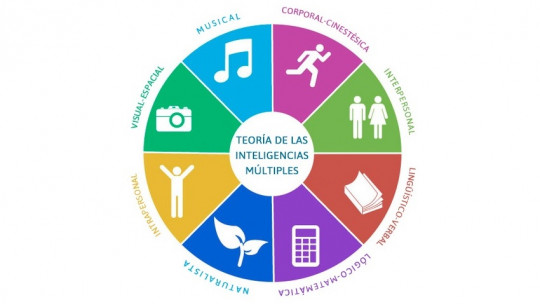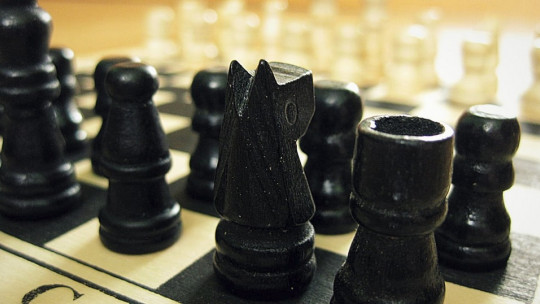
The Theory of multiple intelligences It was devised by the American psychologist Howard Gardner as a counterweight to the paradigm of a single intelligence.
Gardner proposed that human life requires the development of several types of intelligence, and that each of which encompasses a series of abilities that, despite involving the capacity for abstract thought, go beyond what is conventionally understood by ” be smart” or “be mentally agile” and despite that they are useful in helping us face the always changing and unpredictable challenges that life exposes us to.
Thus, Gardner does not contradict the scientific definition of intelligence, as the “ability to solve problems or create valuable goods”, but at the same time he rethinks it in a radical and, why not say it, also controversial way. This is what makes the Theory of Multiple Intelligences so interesting.
Is there more than one type of intelligence?
To understand the way in which Howard Gardner develops his theory, the first thing to do is to know the initial intention from which he starts: to question the concept of “intelligence” as a homogeneous and unitary psychological trait. It must be taken into account that What until then was understood as intelligence was closely linked to what is known as intellectual quotient (IQ), which is the result offered by the application of intelligence tests.
These tests, in turn, have been developed and perfected for decades, emphasizing the need to obtain objective measures of people’s intellectual capacity even from their childhood. However, this measurement is not free of biases: it has been designed to adapt to the needs of modern Western society, characterized by a sort of specialization and division of labor and by the fact that it places great value on the ability to express oneself verbally and master mathematics and logical reasoning.
When Gardner published his first book on this topic in 1983, the famous Frames of Mind: The Theory of Multiple Intelligences, did so to defend the idea that intelligence does not have to be a unit; It can be understood as several information processing skills that function in parallel and independently of each other. That would mean that someone who, according to intelligence tests, has a low IQ, may be very intelligent in other areas that are not taken into account by this type of psychometric tools.
In this sense, Gardner was inspired by the theories of social constructionism to say that what is usually called “intelligence” is socially constructed, and that means that it does not have to be a natural psychological element (that is, it does not have to be something that exists independently of the historical and cultural phenomena that influence our way of measuring mental abilities).
What are the multiple intelligences?
The history of the theory of Multiple Intelligences begins in the late 70s, when Howard Gardner and his collaborators at the prestigious Harvard University They warned that academic intelligence (obtaining qualifications and educational merits; academic record) is not a decisive factor in determining a person’s intelligence. From his point of view, it was necessary to develop a more open and plural concept of “intelligence” than that which had been used until then.
A good example of this idea is seen in people who, despite obtaining excellent academic qualifications, have significant problems relating to other people or managing other facets of their lives. Gardner and his collaborators could affirm that Stephen Hawking does not have greater intelligence than Leo Messi but each one of them has developed a different type of intelligence.
On the other hand, Howard Gardner points out that there are clear cases in which people have extremely developed cognitive abilities, and others have very little developed ones: It is the case of the savants An example of a savant was Kim Peek, who although he generally had little ability to reason, was able to memorize entire maps and books, in virtually all their details.
These exceptional cases made Gardner think that intelligence does not exist, but that there are actually many independent intelligences.
Multiple intelligences: 8 types of intelligence
Howard Gardner’s research has managed to identify and define up to eight different types of intelligence We are going to learn in more detail about each of the intelligences proposed by Gardner’s Theory of Multiple Intelligences below.
► Linguistic intelligence
The capacity of master the language and being able to communicate with others is transversal to all cultures. From a young age we learn to use our native language to be able to communicate effectively.
The linguistic intelligence It not only refers to the ability to communicate verbally, but also to other ways of communicating such as writing, gestures, etc.
Those who best master this ability to communicate have superior linguistic intelligence. Professions in which this type of intelligence stands out could be politicians, writers, poets, journalists, actors.
How to improve linguistic intelligence?
If you want to know more about verbal intelligence and how to progress in this area, we invite you to read the following article:
► Logical-mathematical intelligence
For decades, the logical-mathematical intelligence was considered raw intelligence. It represented the main axis of the concept of intelligence, and was used as a scale to detect how intelligent a person was.
As its name indicates, this type of intelligence is linked to the ability to logically reason and solve mathematical problems The speed in solving this type of problems is the indicator that determines how much logical-mathematical intelligence one has.
The famous IQ test (IQ) are based on this type of intelligence and, to a lesser extent, on linguistic intelligence. The scientists, economists, academics, engineers and mathematicians They usually excel in this kind of intelligence. Likewise, chess players also require logical ability to develop better game strategies than their opponent’s, and in turn anticipate their moves.
Is it possible to improve logical-mathematical intelligence?
Of course. We explain everything you need to know about this type of intelligence and the keys to improving it here:
► Spatial intelligence
Also known as visual-spatial intelligence, it is the ability that allows us observe the world and objects from different perspectives Chess players and visual arts professionals (painters, designers, sculptors…) stand out in this intelligence, as well as taxi drivers, who must have an exquisite mental map of the cities they travel through.
People who excel in this type of intelligence usually have abilities that allow them to create mental images, draw and detect details, as well as a personal sense of aesthetics. In this intelligence we find painters, photographers, designers, publicists, architects, creatives.
How can we increase our spatial intelligence?
It is a skill that can be improved. Here you have all the information:
► Musical intelligence
Music is a universal art All cultures have some type of music, more or less elaborate, which leads Gardner and his collaborators to understand that there is a musical intelligence latent in all people.
Some areas of the brain perform functions linked to the interpretation and composition of music. Like any other type of intelligence, it can be trained and perfected.
It goes without saying that the most advantaged in this kind of intelligence are those capable of playing instruments, reading and composing musical pieces with ease.
►Bodily and kinesthetic intelligence
The body and motor skills that are required to handle tools or to express certain emotions represent an essential aspect in the development of all cultures in history.
The ability to use tools is considered kinesthetic body intelligence On the other hand, there is a following of more intuitive abilities such as the use of bodily intelligence to express feelings through the body.
Dancers are especially brilliant in this type of intelligence, actors, athletes, and even surgeons and plastic creators since all of them have to use their physical abilities rationally.
► Intrapersonal intelligence
The Intrapersonal intelligence refers to that intelligence that enables us to understand and control one’s internal environment in regards to the regulation of emotions and attention focus.
People who excel in intrapersonal intelligence They are able to access their feelings and emotions and reflect on these elements According to Gardner, this intelligence also allows you to delve into your introspection and understand the reasons why you are the way you are.
On the other hand, both knowing how to distance oneself from the situation to de-dramatize events with a negative emotional impact and knowing how to identify one’s own thinking biases are very useful tools both to maintain a good level of well-being and to perform better in different aspects of life.
How to improve this type of intelligence?
There are several ways to know yourself better. We have summarized them for you in this article:
► Interpersonal intelligence
The Interpersonal intelligence It empowers us to notice things about other people beyond what our senses can capture. It is an intelligence that allows us to interpret the words or gestures, or the objectives and goals of each speech. Beyond the Introversion-Extraversion continuum, interpersonal intelligence evaluates the ability to empathize with other people.
It is very valuable intelligence for people who work with large groups. His ability to detect and understand the circumstances and problems of others It is easier if you have (and develop) interpersonal intelligence. Teachers, psychologists, therapists, lawyers and educators are profiles that usually score very high in this type of intelligence described in the Theory of Multiple Intelligences.
More about interpersonal intelligence and how to improve it
We explain how to expand these empathy and communication skills here:
-
“Interpersonal intelligence: definition and tips to improve it”
► Naturalistic intelligence
According to Gardner, the naturalistic intelligence It allows you to detect, differentiate and categorize aspects linked to the environment, such as animal and plant species or phenomena related to climate, geography or natural phenomena.
This type of intelligence was later added to Gardner’s original study on Multiple Intelligences, specifically in 1995. Gardner considered it necessary to include this category because it is one of the essential intelligences for the survival of human beings (or any other species) and that has resulted in evolution.
It should be noted that although for Gardner this type of intelligence was developed to facilitate the creative use of the resources that nature offers us, currently its use is not only limited to environments in which there are no human constructions, but the latter also they could be “explored” in the same way.
In detail
You can learn more about the eighth type of intelligence in this post: “Naturalistic intelligence: what is it?”
What is my type of intelligence?
Gardner states that all people are owners of each of the eight types of intelligence, although each one stands out more in some than in others, with none of the eight being more important or valuable than the others. Generally, it is necessary to master a large part of them to face life, regardless of the profession one practices. After all, most jobs require the use of most types of intelligence.
The education taught in classrooms strives to offer content and procedures focused on evaluating the first two types of intelligence: linguistic and logical-mathematical. However, this is totally insufficient in the project of educating students to the fullness of their potential. The need for a change in the educational paradigm was brought to debate thanks to the Theory of Multiple Intelligences proposed by Howard Gardner.
Criticisms of the Theory of Multiple Intelligences
Although it is true that Gardner’s theory of Multiple Intelligences has gained a lot of popularity in areas such as education professionals, in the world of Psychology it is much more controversial. The main criticisms it has received have to do with the fact that beyond abstract theories, there is scientific evidence that, in general, Obtaining a good score on a certain set of tasks in intelligence tests helps predict a good result on the rest of the tasks as well although they involve quite different types of abilities (remember that even the concept of unitary intelligence presents different sub-divisions).
For example, people who are good at solving math problems quickly tend to also be skilled at reading comprehension exercises or detecting patterns in series of images. This implies that although it is absurd to understand intelligence in a very limiting and hermetic way, it is not entirely true that there are intelligences that are totally independent of each other; Now, it is perfectly possible for a person to be very bad at one type of intellectual challenge and, on the other hand, be brilliant at others.
On the other hand, Howard Gardner has pointed out that the important thing about his theory is not the 8 intelligences that he proposes, but the conceptualization of human cognition as parallel and relatively independent processes from each other. For this reason, he has pointed out several times that possibly multiple intelligences are not the ones he proposed, but others that he has not taken into account or that he groups under the name of a single intelligence.
Report to Howard Gardner on Multiple Intelligences
If you want to delve deeper into the Theory of Multiple Intelligences and the reasoning and evidence of its main author, Howard Gardner, we highly recommend that you watch this chapter of the program on neurosciences and psychology Networks








